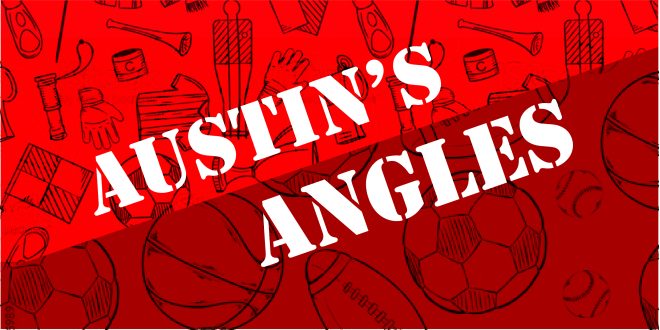I’m sure every college sports fan at this point is well aware of the ongoing massive wave of conference realignment that’s sweeping the nation.
While college athletics is no stranger to realignment, this wave is unlike any that have been seen before.
Today, I’ll be sharing my thoughts on whether conferences have gone too far in their quests for power, as well as where VSU stands in the realignment picture.
What kicked off realignment?
First and foremost, when did this round of realignment begin? For that, we have to take a look at a conference that is a repeat offender: the Southeastern Conference (SEC).
The SEC triggered the current wave of realignment by dipping into the Big 12 Conference and adding powerhouses Texas and Oklahoma in July 2021. The resulting shockwave caused a domino effect that affected not only the Big 12 but also the American Athletic Conference (AAC), the Sun Belt Conference, and Conference USA.
Still, while that portion of realignment is drastic, I believe that this part of realignment was actually rather tame. Sure, many rivalries and traditions went to the wayside with these moves, but for the most part, most of the moves made sense.
The detonation of the Pac-12
However, realignment did not stop there. In June 2022, the Big Ten Conference, a conference primarily situated in the Upper Midwest, added Southern California and UCLA from the Pacific-12 Conference (Pac-12).
That move caused a seismic shift in the college athletics landscape that has decimated the Pac-12.
On July 27, Colorado announced they would return to the Big 12 after 13 years in the Pac-12. A week later, Oregon, Washington, Utah, Arizona and Arizona State all also departed. Oregon and Washington will be joining USC and UCLA in their move to the Big Ten, while Utah, Arizona and Arizona State will be joining Colorado in the Big 12.
The Pac-12 then saw two more of its members depart for the Atlantic Coast Conference on Sept. 1 when the ACC officially voted to add Stanford and California, as well as AAC member SMU. All three of those schools agreed to join the conference at a reduced rate, with SMU agreeing to join without receiving a dime from the ACC’s media rights deal for their first seven years in the league.
The mass exodus of schools from the Pac-12 has left the conference with just two remaining schools, Oregon State and Washington State. Both schools have filed a joint restraining order against the other 10 schools to prevent them from determining what happens with the Pac-12’s remaining assets.
This isn’t the first time a “power conference” has been ripped to shreds by realignment. However, this round of realignment has by far been the most disruptive round of realignment in recent memory in more ways than one.
An end to tradition (and geography)
Simply put, conferences have traditionally been regional based. The whole point of conferences from an athletic standpoint was to alleviate travel costs for games by giving schools a regular rotation of opponents.
Geography has gone out the window with this wave of realignment. For example, the Big 12 in 2024 will now span from Arizona to Florida, and from Utah to West Virginia. The ACC will be even more bizarre, stretching from Miami, Florida, to Berkeley, California.
When the dust ultimately settles in 2024, many of the major rivalries’ fans had grown to love over the decades will be ended. Despite notable rivalries such as the Holy War (BYU-Utah) and the Lone Star Showdown (Texas-Texas A&M) returning, the number of rivalries lost will far outweigh those that are gained and formed over the next several years.
What about the student athletes?
Coaches and fans alike have voiced their opinions against realignment. Missouri head coach Eli Drinkwitz, among others, posed perhaps the most important question in all of this: what about the student athletes?
“We’re talking about a football decision they based on football, but what about softball and baseball who have to travel across country?” Drinkwitz said during a press conference on Aug. 5. “Do we ask about the cost of them? Do we know what the number one indicator of symptom or cause of mental health is? It’s lack of rest or sleep.”
Student athletes already go through so much to play the sports they love. Being successful on the field or on the court comes with its own challenges, and when you add in the constant pressure of maintaining good grades to be academically eligible, it can cause many students suffer from mental health issues.
In my opinion, realignment will almost certainly bring about a rise in student athletes being ruled ineligible to play due to poor grades, and it will be because of something they had no say in whatsoever.
Drinkwitz also hinted at another point during his stance: money. Like previous rounds of realignment, this round has been almost entirely predicated on money. The more high-value schools a conference has, the more money television networks and streaming platforms will dish out to that conference in order to broadcast their games.
Football is by far the highest grossing sport for college athletics, and nearly all of the moves made in this wave of realignment have been to bring in high-value football brands. While I certainly won’t argue against football being king in college athletics, letting one sport decide the entire future of college athletics is disheartening.
Where does VSU fit in realignment?
And for those thinking realignment only happens at the highest level of Division I college athletics, it doesn’t. Schools across all divisions are always on the move.
Just take a look at the Gulf South Conference, VSU’s home conference. In 2024, two members of the 13-team conference will depart. The includes VSU’s archrival, West Georgia, who will be moving up to Division I to play in the Atlantic Sun Conference.
By 2025, the GSC will have just five football playing members as North Greenville, Chowan and Erskine College (joining in 2024) move their football programs over to their primary conference, the Conference Carolinas. That means the GSC will be one member short of the minimum number required to sponsor football.
For all we know, another Division II conference such as the Peach Belt Conference or the Southern Intercollegiate Athletic Conference (SIAC) might choose to raid the GSC much like the Big Ten and Big 12 did the Pac-12 or vice versa.
After all, all it takes is one ambitious conference commissioner to rock the boat.
Written by Austin Bruce, Co-Editor In Chief. Graphic courtesy of Gavin Ponder.
 The Spectator The independent student newspaper of Valdosta State University
The Spectator The independent student newspaper of Valdosta State University







